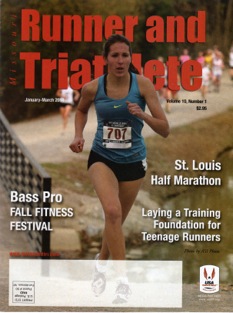Foundation Training
for Teenage Runners
By Roy Stevenson

Racing well depends on your ability to maintain a fast pace for the entire length of the race, then being able to run even faster at the end. Some runners are more physiologically gifted in these areas than others, but I’ve seen many runners of lesser ability beat runners with more talent because the talented runners did not work as hard in training. It happens all the time.
The point is, every runner can develop his cruising speed and fast finish with the right foundation training. How do we go about achieving these goals? First, it’s important to realize that doing just one type of training does not develop these skills. Many coaches are “one note coaches” who only have their runners do one thing in training, such as long slow running, for example. Others beat their runners up by having them do interval training 4 or 5 days a week, which may have the runners racing well for a few short weeks, then crash miserably just when the championship races are held at the end of the season.
Here are several types of foundation training that most high school and collegiate coaches use in their schedules, in varying degrees.
1. Long slow distance. This technique lays the aerobic base for the faster work that is to follow as the racing season approaches. Here, the running is kept slow and steady during the conditioning phase. Young runners can do far more than you or they think possible. A good rule of thumb is for a teenage runner to do ten miles plus his age in their long run, and they can often handle more than this. E.g. a 15 year-old can handle a 15-mile run easily if he is healthy.
One thing that many coaches fail to do is to program in an easy week every third or fourth week, where the length of each distance run, and the intensity or pace of each run, are reduced. This is called periodization and ensures that the athletes recover from their training. Cutting half an hour off the runs, and slowing down their pace, gives teen runners a programmed recovery, and they’ll bounce back the following week when they resume their normal schedules, and they’ll be able to handle more training then previously. It works like magic.
2. Tempo Running. Once every week, there is a need for the coach to introduce some faster paced running over long distances. Tempo running has many benefits including simulating race pace, developing anaerobic threshold and lactate tolerance, and increasing stride rate and leg speed. These are done over an intermediate length distance, on a track or measured level surface, and are times. The runners should aim for a steady pace and fast finish over the last 800 meters.
3. Hill Running. Hills provide extra resistance that further increases leg power, recruits fast twitch muscle fibers (to develop that fast finish), improves lactate tolerance, increases oxygen consumption, and increases leg turnover. Hill training can take many forms, from doing repeats over 100, 200, 400 or 600 meters, with a jog back down the hill, or sustained pace running up the hill, during long runs.
4. Strength Training. Some form of resistance training is necessary to develop lactate threshold, running economy, neuromuscular coordination, correct muscular imbalances, improve core stability, and increase stride length. Jack Daniels, one of the country’s foremost coaches says, “For a beginning runner, gaining strength might be as important as running itself, and for an experienced runner might make the difference in whether or not you reach some lofty goals”. Resistance training will be covered in more detail in a future issue of this magazine.
Adequate rest days of slow jogging should be planned between these high intensity workouts, and as long as they are done slowly, young runners can run comfortably up to one hour without ill effects. The runner should pay attention to a healthy balanced diet to ensure the muscles are being restocked with glycogen, and that normal growth and development are taking place.
Savvy coaches experiment with several of these foundation training techniques, and blend them into a program that works for their athletes. It’s okay to experiment, as long as you are discarding what does not work, and including what does seem to work. A good coach should always be evolving his programs and schedules.
You can find more information about hill running, tempo running and much more at
Return from Foundation Training to Running Articles
Return from Foundation Training to Home Page